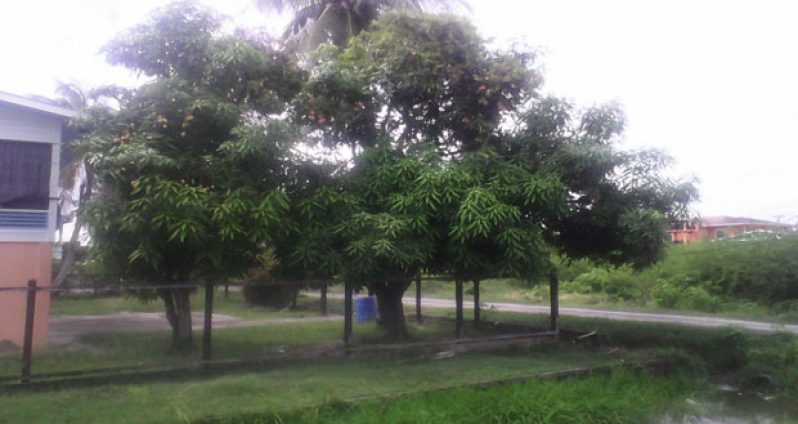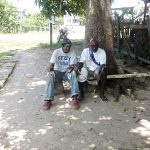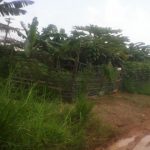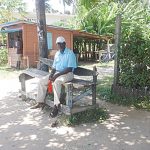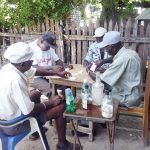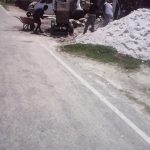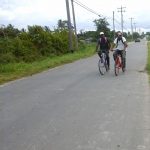THIS week, by demand, we selected a quaint little village located on the outskirts of the West Berbice District, nicely put away as a dreamy little alcove where smiling residents enjoy the lush riches of the countryside.While one may be drawn to the city and its environs for its extensive commercial and economic opportunities, the quieter at heart would be lured to the countryside with the assurance that they can bask in the exciting atmosphere of the tropics as they enjoy the jovial banter, rich camaraderie, and of course the abundant avenues for pleasant recreation that are, in many cases, associated with the countryside.
Well, here I was yet in this very pretty village called #42 Village (also called Seafield Village) on the West Coast of Berbice, and judging from the visible stream of activity here, I just knew that the experience would be worth my while.
I was well stirred up by the almost mesmerising manner in which the houses were all clustered together, beautifully accentuated by abundant fruit trees and ‘flower plants’ blooming in picturesque glory in many yards.
In some yards, small kitchen gardens thrived under the lusty sunlight as plants welcomed precious water filtering to their roots through the rich, black ‘country soil’ which mothers happily saturated with the life-saving liquid from water cans.
Youths dashed after each other noisily through the alleyways, while others were more contented to engage themselves in highly competitive games of hop-scotch or marbles.
In the few yards that featured makeshift stalls, mothers — and even husbands — busied themselves with setting out groceries, vegetables and ground provisions, intent on making a quick, honest dollar.
As is customary with these villages, cows grazed lazily in wide open fields, and young lambs chased after their mothers, bleating noisily in their special ‘sheep language’ as they jostled the moms roughly, trying to get their fill of warm breast milk.
This village falls under the administrative division of Region 5 (Mahaica/Berbice), in which an average elevation of one metre above sea level applies. As history would suggest, the village can have low impact earthquakes (on average one every 50 years), with occurrences at 5 on the Richter scale. When an earthquake occurs, it may be felt indoors by many people, and outdoors by a few people during the day. At night, some people may be awakened. There is a low occurrence of periods with extreme drought. Flooding risk in this village is said to be very low, except for some backland areas occupied by squatters.
Those residents living in the outskirts of the backlands say they are endangered by snakes and alligators when rainfall is heavy.
The landscape is mostly covered with closed to open, broad-leaved evergreen or semi-deciduous forest. The climate is classified as a tropical wet (no dry season) with a tropical moist forest bio-zone. The soil in some areas is said to be high in acrisols, alisols, plinthosols, acid soil with clay-enriched lower horizon and low saturation of bases.
With a population of close to one thousand residents, this village is located at just over 68 miles from Georgetown.
MY ARRIVAL
I was expecting the customary hustle and bustle of inhabitants, noisy streets, screaming children and raucous males ‘taking a tupps’ in the rum shops, and was in no way prepared for the intensely pleasant, calm and tranquility that seemed to engulf me the moment I stepped out of the minibus and into the dusty but very tidy main road.
As the cool and refreshing wind blew in from the Atlantic Ocean, I marvelled at the soft swaying of coconut palms which almost seemed to move with a strangely sweet, rhythmic grace that gave me a strange tingle. Such a riveting picture of Mother Nature at work, and this dazzling spectacle seemed to be even mirrored in the flashing eyes and mischievous smiles of every villager I met and spoke with.
Upon my approach and a brief explanation of the reason for visiting, an elderly woman (though cameras shy) gurgled excitedly: “I does read the Chronicle every Sunday and ah de wandering when y’all coming tuh dis village. Eh-eh! Like y’all de fuget we or wha, sir?” She led me to some of her friends and associates, loudly proclaiming the reason for my visit.
The food vendors were falling over themselves to ensure I sampled their black and white puddings and still steaming sugar cakes. They even insisted that I devour a heaping plate of well made ‘country polouri.’
There were a few persons sitting by the roadside or enjoying some ‘swank’ (drink made from limes), while others were perched on their front steps or verandahs seemingly so content with life that I truly envied their apparent solace and natural comfort.
The older folks would normally enjoy a good game of dominoes and some good old Guyanese rum during their spare time.
This village is nestled cozily between the attractive villages of Rising Sun to the east and # 41 Village to the west. Like many other villages in Berbice, this one certainly has rich historical connections; and as history would dictate, was actually one of the portioned lands or settlements sold to Africans after slavery was abolished.
INTERACTING WITH VILLAGERS
Elderly Villager Clement Richards, commenting on the issue of the country’s new governance, expressed hope that the new Government would do all in its power to create an environment that would be beneficial to all Guyanese.
“While I am particularly pleased that we have acclaimed a new Government, my expectation is that they work relentlessly in creating an atmosphere that is free and fair for all, and aspire towards ensuring that Guyana becomes a land where ethnic unity is prevalent. I would also like to see the new Government focus on areas of economic development that will benefit the Guyanese people and the country as a whole,” he pontificated.
Among the many persons who were more than ready to interact with the Chronicle was Carol Smith, a teacher at a secondary school some three villages away. This very jovial woman indicated that unemployment was a major setback for the village, since some students who would have written the CXC examinations remain at home, or wandered in the streets as they desperately await responses from places to which they had applied for jobs. She noted that it was just a few that were actually able to relocate to the city and obtain good jobs, since they often cannot afford the expenses of housing and other city responsibilities once they relocate.
Ms Smith noted that, because of this reason, there are several intelligent youths remaining in the village, deeply frustrated by the problem of unemployment. She added that all the schools would have been already filled with teachers, thus making it impossible for some qualified school leavers to obtain employment there.
Inadequate recreational opportunities were also another issue that really peeved Ms Smith. “Seafield is in dire need of adequate recreational facilities for the youths; and though a gentleman here is upgrading our playfield, we would certainly welcome more sporting facilities from other donors. We also definitely need variety where our recreational opportunities are concerned,” she declared plaintively.
She disclosed there is need for corporate and government intervention, emphasising that the village had, over the years, been champions in the circle tennis arena. She said that, over the years, this game has disappeared almost entirely from the village due to lack of funds to provide gear, or unavailability of incentives for players.
Housewife Princess Walters had a much horrifying tale to tell. She related that the village is targeted by outsiders, who come in the quiet of the night to throw garbage in sections of the village.
“These people are just terrible and heartless. Persons who operate businesses and other individuals come in the still of the night when we are sleeping, and sometimes dump garbage on our street corners or in open fields. Just last week, the boys chased a truck driver, who attempted to dump a whole truck load of garbage in a vacant lot,” she divulged.
Several villagers are calling for their own Health Centre, since they have to travel to the nearby Bush Lot Health Centre or Fort Wellington Hospital, which also has to accommodate villagers from Hopetown and Bush Lot itself, apart from other areas.
Sharon Thomas, who spoke to us from an open window on the bottom flat of her two-storeyed home, explained that she was at home alone with her 15-year-old daughter while her common-law husband, ‘Brandon’, was out plying his trade as a bus driver within and outside the village.
She noted, however, that while his profession can be tedious and very competitive at times, it brings in a sizeable daily dollar that somehow manages to take care of their needs in the home.
Ms Thomas said she has been residing in the village for over 25 years, and it was indeed a very beautiful and peaceful location in which residents live in harmony and great love for each other.
Villagers are also requesting street lights for safety, while farmers cultivating rice and cash crops in the backlands are complaining that the dams are mostly intolerable during the rainy season, making it almost impossible to transport their harvests at the appropriate times.
In some sections of the village, residents are lauding the fact that the relevant authorities have begun work on a few dams. Presently, a public-spirited resident is working on the playfield in the village, and has begun making great strides in the areas of sports and entertainment.
Some persons complained that they are unable to garner proper prices for their poultry products when they sell to wholesale buyers, who many times attempt to give them ‘next to nothing’ for their produce. They said the constraints of transporting such items to the city to net better sales are too expensive, and they would require proper storage containers (refrigerators etc.)
Others living close to the backland areas related that when there are torrential downpours, their yards would flood, and snakes and alligators would crawl into their homes.
Villagers are requesting that a bridge be built on the sea dam to grant proper access to the sea beach, which is divided from the village by waterways.
This village seems lacking in terms of obvious business potential, as can be judged from its distinct infrastructure, but villagers are certainly not missing out on anything in particular since they can simply take a bus to the not so distant Bushlot which serves as an ‘economic hub’ that can ultimately satisfy their entertainment, relaxation, social and of course economic needs at any one time. They can also grab a few supplies at the Maj & Family Grocery Store, whenever they seem please.
Today, Seafield is located in quite a quaint and impressive village that is still trying its best to keep up with the changes associated with modernisation. New and, in many cases, posh houses have been built and the village is now a starling combination of somewhat classic buildings and sprawling, majestic pastures that project a refreshing spectacle as cattle, goats and sheep graze contently, munching noisily on the juicy looking grass and shrubs.
The sight of men on horses chasing cows down a few dams brought a vivid reminder that this was a location where poultry farming and cattle rearing at one time brought in vibrant incomes for many residents.
The main road is in perfect shape, and the canals are reasonably maintained. Residents rave that there is hardly any challenge in the village, save for the few dams which become intolerable during inclement weather.
Residents enjoy continuous electricity, a constant supply of potable water, and they ensure their village is kept clean through self-help initiatives and burning of garbage and refuse.
Farming would have dwindled in its intensity, and this is so because of the ‘salty content’ that is now present in the soil, which damages crops instead of causing them to flourish as expected.
ENTERTAINMENT
The village is seized in the clutches of an ‘entertainment shutdown’, as dictated by some residents, and as such folks are forced to remain in the confines of their homes and watch television, or enjoy drinks with friends and neighbours.
In times gone by, Seafield was one of the more popular ‘entertainment hubs’ on the West Coast of Berbice, since it was home to the very popular ‘Leg Trap Disco’. In that era, huge masses of people used to congregate there on weekends for wild revelling as they enjoyed the many concept parties being hosted. With the hotspot now gone, villagers either anticipate birthday or wedding celebrations, while some may venture to other villages, like Belladrum and Rosignol, for exclusive entertainment.
RELIGION
Most of the residents in this village are Christians, and would normally worship at three major churches in the village. These are the Seventh Day Adventist, the Christ Lutheran and the New Apostolic. That aside, a few would keep church sessions under their homes, while the mere sprinkling of Muslims would normally worship outside the village.
The village awakes to the golden streams of sunlight, and soon after, children would be seen tumbling out in their yards, sleepily rubbing their eyes or grumbling under their breaths as mothers loudly admonish them to have their morning chores done.
By the time the sun is fully up, children begin to spill into the streets, some under parental supervision, as they make their way to the primary school or to other schools outside of the village. The few small shops are open by now, desperately trying to net morning sales, as some mothers thread into their kitchen gardens for fresh vegetables or seasonings for their meat kind.
Vehicles begin to traverse the streets even as pedestrians began to trek along the many alleyways and side streets, intent on getting urgent errands completed.
The few larger shops soon open their doors and windows to garner daily sales, and a few snack vendors put out their trays of biscuits and confectioneries, as they ready to ‘bellow’ their prices and bargain arrangements.
As the sunlight creeps fully over the gold-crusted morning crowds, the village bursts into a tingling fusion of merry laughter, happy voices, and the rumbling of vehicles as they wend their way along the main road.
By now the golden sun is rising steadily above the horizon, casting a jewelled dazzle on rooftops and the metal frames of steel fences. Soon after, the many small groceries that have sprung up are opened, as vendors attempt to attract the eyes of early buyers. With streets now filled with pedestrians, riders and drivers, conversations with a few grown men revealed that while the village can sometimes be described as ‘a hub of bustling activity’, there is still room for the introduction of some more ‘glitz and glamour’.
During the midday, the street is mostly dismal. It comes alive in the afternoons and early mornings with the boisterous chatter of students as they hurry to and from school.
THE PAST
According to village elder Clarence Adams, this village in days gone by was just a cluster of somewhat shabby houses several years after the abolition of slavery. He said that in many cases the houses were far apart, so the present camaraderie and jovial interaction of residents was not present then, because of the distance that separated houses.
Streets were not paved, and residents depended on the few stand pipes in the village for their water supply. Some persons in those days used trench water, which they boiled before drinking.
He reminisced on the days when there would be fiery disagreements at the pipes over whose turn it was to dip water, and in some cases there would be pulling of hair and scratching of faces to obtain the precious liquid.
“It was always a pleasure to draw water when the ladies of the village came out. They would gather around with dresses hugging their hips, with hands on their waists, feet tapping impatiently if someone was wasting the water or taking too long to fill their containers. Many times heated arguments broke out, and in some cases the ladies were locked in battle, much to the delight of those standing by. Often it was a good tussle and wallowing in the mud before they were separated by men folks, who would secretly enjoy the fights to a point before separating them.”
In those days, agriculture was the main source of support for some families, and many persons farmed in the backlands or maintained a kitchen garden at home. The dams leading to the backlands were okay during the sunny season but became almost impassable during the rainy weather.
Ms Small said that entertainment in those days would include beating drums around large bonfires, and engaging in dancing in wild abandon as villagers sought to maintain their African culture. She said that villagers eagerly anticipated the coming of weddings or birthdays, since those heralded great festivity and celebration. Most villagers loved the ‘Que Que’ sessions before weddings, since they could gyrate and unleash their ‘forbidden sides’ as they consumed alcohol, metagee, cow face souse, black pudding and other delicacies.
Drainage was not as good as it is today, and some areas experienced flooding, according to Ms Small.
Many spent their hard-earned dollars and did work on the swampy lands, building it to perfection to accommodate houses, shops and other structures.
Man-made streets and pathways soon began to appear, and families could be seen toiling assiduously in the broiling sun to build their paths and alleyways leading to their respective homes.
EMPLOYMENT
This village, it seemed, was not affected by unemployment, since its inhabitants were either working in other areas or gainfully employed as shop owners, farmers, or minibus drivers.
It was a pleasurable sight to watch mothers watering young vegetable plants as their kids trailed after them, trying to be of some assistance in one way or the other.
In a few homes, the ladies were busy cooking and the succulent aroma of polouri, egg balls, dhal puri, and fried chicken wafted into the air. These items will be displayed in tidy looking little glass cases later in the afternoon for sale to villagers and school children as they trekked home to their various houses.
And some seemed to be making quite a fortune on the sale of custard blocks, icicles, cubed ice, and cool down (local fruit juice in plastic bags). I almost giggled out loud at the amusing sight of little boys attempting to lick the apparently delicious trails that ran down their wrists and even elbows as the custard blocks melted in the sun.
This village is simply adorable, and the way in which residents attempt to meet their needs through self-orchestrated means is truly amazing.
However, a few youths complained that they are unable to obtain jobs inside the village, since there is actually no scope for ‘qualified employment’ there. Some said positions in administrative offices close by were already filled, forcing them to seek work in the city, where the constraints of accommodation and bills pose major financial problems.
CONCLUSION
Despite its apparent lack of economic opportunities, #42/Seafield Village boasts a rare ‘yesteryear allure’ that is certainly stirring and refreshing to the soul. Its beauty lies in the rich, lush greenery, its sandy dams, bubbling waterways and jolly banter of its seemingly happy people.
By Alex Wayne
Take a trip there and you just may become addicted to its alluring simplicity.




.png)


